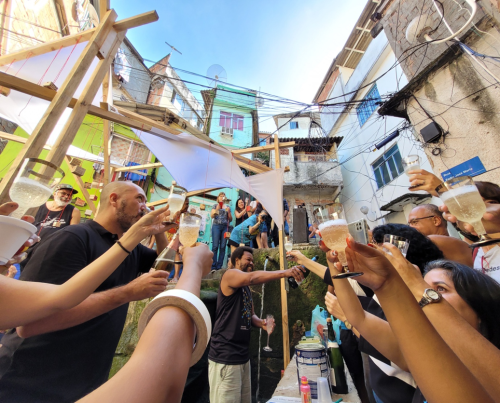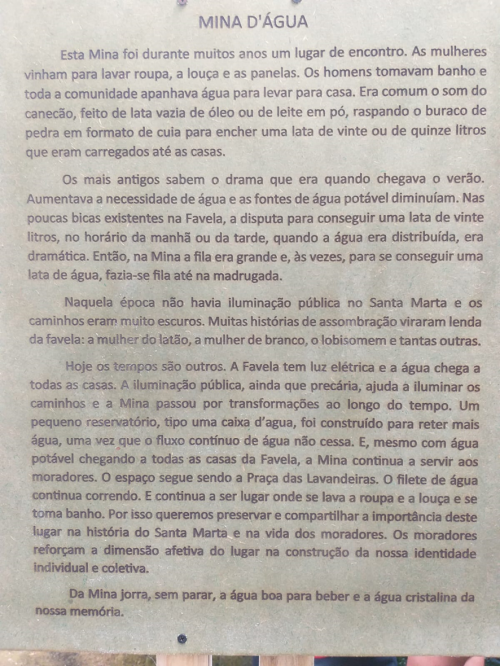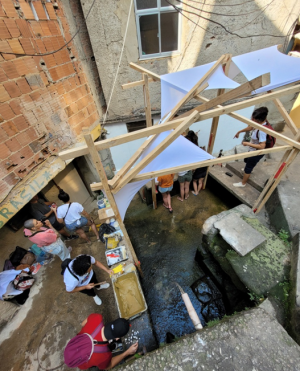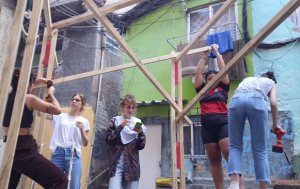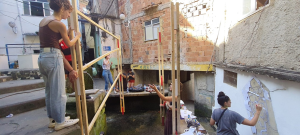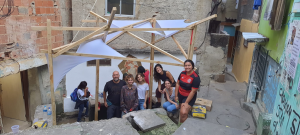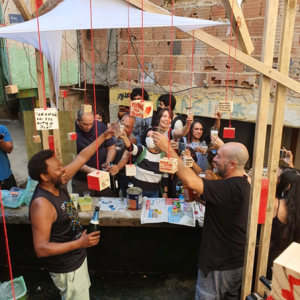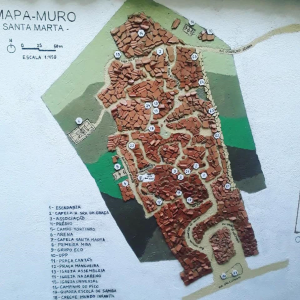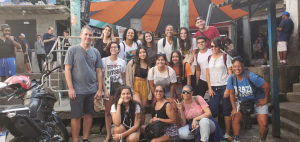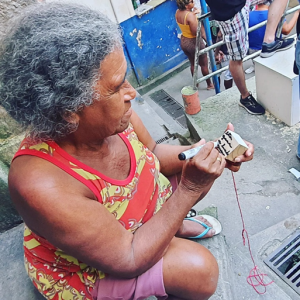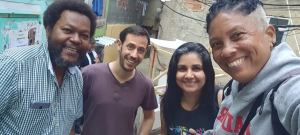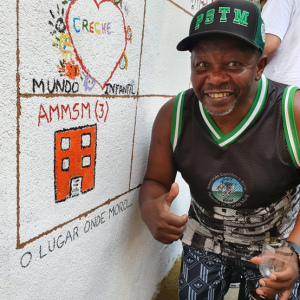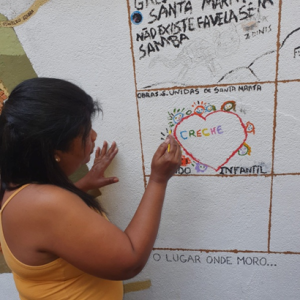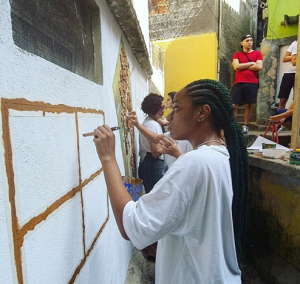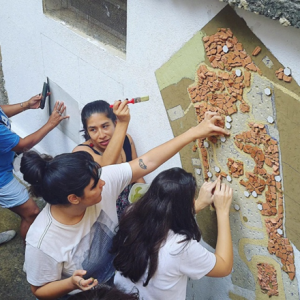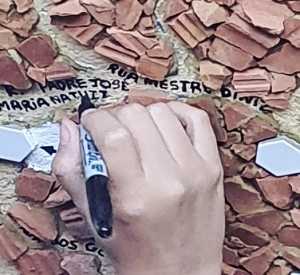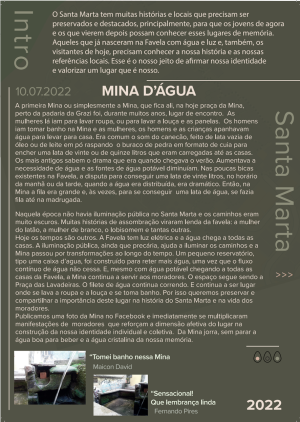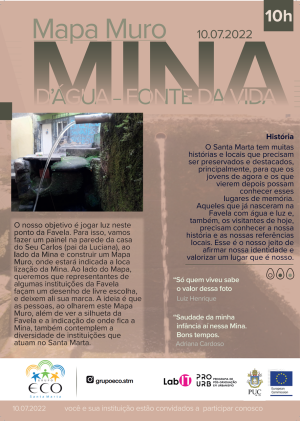The cohesive city addressing stigmatization in disadvantaged urban neighbourhoods (report)
The "MAPA MURO MINA SANTA MARTA" Case Study concluded the CoCreation Project, addressing the stigmatization of peripheral territories. The artistic intervention reclaimed the memory of the first water mine in the Santa Marta favela, symbolizing symbolic occupation and collaboration between the university and the community. The CoCreation method highlights challenges in building a just city, reinforcing the need to listen to and respect favelas to achieve a more democratic urban future. Entry created from the Case Study, in the Santa Marta favela, after the closure of the Workshop - Santa Marta Without Borders - in August 2018.
Authorship: Information from the entry reproduced by the Marielle Franco Favelas Dictionary Team from other sources.
Click here to access the text in Portuguese
Introduction
The decision and the opportunity to carry out this Case Study in the Santa Marta favela came during the last evaluation meeting after the end of the Workshop - Santa Marta Without Borders -, in August 2018.
On that occasion, with the participation of more than twenty international partners : professors and researchers and PhD students from the Universities of Oxford-Brookes, Bath and UNAM; researchers from three European NGOs - European Alternatives, Tesserae and City Mine(d) - and with professors and PhD students and undergraduate students at PUC-Rio and members of the Grupo Eco/favela Santa Marta project, a partnership was consolidated that unfolded in the following two stages:
a) the organization of the International Seminar in June 2019, at PUC-Rio;
b) the debate on public space in the Santa Marta favela, which was chosen as the theme chosen by Grupo Eco together with the PUC-Rio team for the development of the Case Study, whose moment of concretization/completion took place at the event of the construction of the MAPA MURO MINA Santa Marta, on July 8, 9 and 10, 2022, with the inclusion of teams of professors of Architecture and Urbanism from PUC-Rio and UFRJ (Labit), in addition to Grupo Eco and the Social Sciences team from PUC -River. The participation of PhD student Oscar Puig, from Oxford Brookes, took place through participation in several meetings during the period of July/August 2019, during the pandemic via zoom, and finally the participation of Oscar in the July 2022 event.
Since 2018, it has become clear to the PUC-Rio team that we could advance in that partnership with Grupo Eco, establishing a debate in collaboration with two universes of reflection – academic and popular activism, usually mixed with some form of artistic intervention, a recurring practice in history of Grupo Eco, in the Santa Marta favela.
This partnership with the Grupo Eco team was fundamental for us to program the activities foreseen in the Co Creation project, since the favela is the place that best represents urban segregation and the stigmatization of those territories and their residents.
In Rio de Janeiro, according to data from the 2010 Census, IBGE, there would be 763 favelas in the city, which house 22% of the population of the city of Rio de Janeiro. Which makes the capital of Rio de Janeiro the Brazilian municipality with the largest number of residents in favelas: 1,393,314 inhabitants. And in the case of Rio de Janeiro, the Santa Marta favela is a “good case for thinking about” long-term aspects of urban segregation, one of the favelas in which social distance – of class, racial, place of residence – coexists with the spatial proximity, as the favela is located in a neighborhood in the city's upscale area, the south zone.
The participation of architecture professors from PUC-Rio and UFRJ in the International Seminar (June 2019) was fundamental to seal a partnership in the last stage of the project, the Case Study, whose construction of MAPA MURO MINA SANTA MARTA and its surroundings were the work of of artistic intervention of those professors and researchers, members of their laboratories. The MAPA MURO proposal was suggested by Professor Adriana Sansão, the creation of her mentor in her master's degree and a member of her laboratory, the architect Gabrielle Rocha, a former student at PUC-Rio and born in the Rio das Pedras favela, Rio de Janeiro.
The idealization of the space, as we will show in photos and videos, was the result of close collaboration between the architects, the architects, in tune with the institutions and projects of residents of the Santa Marta favela, with the leadership of Grupo Eco. This intervention, which culminated in the event on the 8th, 9th and 10th of July, was the result of a rich debate between all the partners of this Case Study, over the months in which this intervention project was being conceived, especially between March and July 2022.
The debate on public space within the favela began with the request for photographic records from the young participants of Grupo Eco, accompanied, sometimes, by undergraduate students from PUC-Rio, in the months of July and August 2019. by the testimonies of different generations about what it was like to live in the favela compared to the present time.
From those first records, it became clear that the scarcity of space, in general, and specifically of free area for leisure moments, constituted a great challenge for the residents. Generations of elderly people easily moved around the favela for their leisure time, such as on weekends; children could run and play in the trees, possibilities that practically no longer exist. The advance of the construction of houses and small commercial stores definitely overlapped with the scarcity of land.
Although in most favelas in the city of Rio de Janeiro the expansion occurs vertically, with the increase in the floors of the houses, the very steep terrain of the Santa Marta favela, which is extremely steep, makes this type of expansion very difficult.
Faced with the scarcity of financing for affordable housing in Brazil, where the housing deficit remains very high (the Brazilian housing deficit is 7.9 million homes across the country, corresponding to 14.9% of total households (2022), the growth of favelas and within favelas occurs in an unplanned way.
This debate process was abruptly interrupted with the Covid19 pandemic and the need to rethink and interrupt the process until we resume in October 2021.
Watch the video that references the project, here!
TV PUC-Rio | Water mine and wall map rescue memory of Santa Marta
Participants
- Professors and students of the Departments of Social Sciences and Architecture and Urbanism at PUC-Rio
- Eco/favela Santa Marta Group; professor and members of Labit, School of Architecture at UFRJ
- PhD student at Oxford Brookes University
- PUC TV team
- Tour Group Members
- Member of the Brazilidade Group
- Members of Folia de Reis
- Members of the Association of Residents of the Santa Marta Favela
- Members of the Santa Marta samba group; etc
Context
The debate emerged from the 2019 International Seminar, at PUC-Rio, identified by the members of Grupo Eco about the importance of public space within the favela. The territory has been successively occupied, in an unbridled way, by the construction of new housing, leaving very little “free” space for leisure for children and families in general.
The streets between the houses narrow, in some places there is a compromise in the ventilation of the houses, with the reduction of distances between the windows and doors, which are very close together; as well as the challenge of ensuring some privacy between dwellings.
This process is not recent, but in view of the increase in poverty[2] the disorderly, savage occupation of favela space is intensified. The lack of regulation transforms the dissatisfaction of the residents who suffer this process into a feeling of impotence in the face of the authority imposed by the force of drug trafficking, with the omission of the security forces – mainly the military police.
Location
The Case Study was concluded with an intervention at the site of the first water mine in the favela, where residents sought water to drink, eat, wash their clothes and belongings, in addition to bathing and cooling off. This place, full of meaning for residents in the history of the favela, was fundamental to their lives until the conquest of running water in their faucets/houses.
This decision on the location of the artistic intervention emerged from the debate between the Eco Group teams, which pointed out the location and importance of the rescue of that first water mine and the creation of a wall map at that location by members of the Laboratory of Temporary Intervention, Labit, UFRJ.
History of the first Mina D'água in the Santa Marta favela
Text prepared by the Eco Group
Wooden plaque installed at the Mine site, text by Grupo Eco and plaque made by the Laboratory of Architecture and Urbanism at PUC-Rio. The text, below, and the photo of the Plate next:
“This Mine was for many years a meeting place. Women came to wash clothes, dishes and pans. The men bathed and the whole community collected water to take home. The sound of the canecão, made of an empty oil or powdered milk can, was common, scraping the stone hole in the shape of a gourd to fill a twenty or fifteen liter can that was carried to the houses.
The older ones know what a drama it was when summer came. The need for water increased and the sources of drinking water dwindled. In the few existing taps in the Favela, the competition to get a twenty-liter can, in the morning or afternoon, when the water was distributed, was dramatic. So, at Mina, the line was long and, sometimes, to get a can of water, there was a line up until dawn.
At that time there was no public lighting in Santa Marta and the paths were very dark. Many haunting stories have become legends of the Favela: the brass woman, the woman in white, the werewolf and so many others.
Today times are different. The Favela has electricity and water reaches all the houses. Public lighting, although precarious, helps to illuminate the paths and the Mina has undergone transformations over time. A small reservoir, like a water tank, was built to hold more water, since the continuous flow of water does not stop. And, even with potable water reaching all the houses in the Favela, the Mine continues to serve the residents. The space remains the Praça das Lavadeiras. The trickle of water continues to run. And it continues to be a place where clothes and dishes are washed and bathed. That's why we want to preserve and share the importance of this place in the history of Santa Marta and in the lives of the residents. Residents reinforce the affective dimension of the place in the construction of our individual and collective identity.
From Mina gushes, non-stop, the good water to drink and the crystal clear water of our memory.”
Events and Activities
The Case Study process began with a series of interviews with favela residents about the use of favela space for living, leisure, work, location in Botafogo, a middle-class neighborhood with most of its population; facilities, positive aspects and their challenges and negative aspects. This stage of the research was interrupted in early March 2020 with the pandemic process. We resumed with virtual meetings, via zoom, in 2021 to plan the future of the project, at that moment interrupted.
During the meetings, the debates on the public space, on the commons and the need to carry out some type of intervention in the favela space guided us to the proposal of building a Wall Map, the experience of an ex-student architect at PUC-Rio and from UFRJ, now a member of Labit, under the coordination of Professor Adriana Sansão. Gabrielle Rocha had built a Muro Map in the favela where she has always lived, the favela of Rio das Pedras, on the west side of Rio de Janeiro.
In 2022, when we resumed the possibility of meeting in person - universities in Brazil were closed in person and only resumed their activities on campuses from March 2022 - we carried out a first guided tour of the favela to decide where to build the wall map.
Launch of the Santa Marta MINE WALL MAP
The launch event of MAPA-MURO MINA Santa Marta took place on Sunday, July 10, 2022. The work on site was preceded by several initiatives and with the fundamental collaboration between several teams from the two Universities involved – PUC-Rio and UFRJ – with the Grupo Eco team and several residents and institutions of the favela, highlighting the partnership with the Brazilidade project.
The numerous meetings and meetings of Grupo Eco with teams from Universities resulted in important work as a record of the memory of the Santa Marta favela and aesthetically approved by all the people involved, but mainly by the institutions and projects of the favela and some of its residents, who spontaneously gave their testimonies. This mobilization in the favela started with the activism of Grupo Eco in the Facebook group with the exhibition of old photos of residents in Mina d´água in past decades. This initiative led to a series of new photos and testimonies about the favela's past at the location of the first water mine.
2.3.2. The proposal to create a Muro Map came from Labit/UFRJ, specifically a work conceived by the architect Gabriela Rocha. The participation of favela residents and institutions and their registration with the respective paintings next to the map took place on Sunday, July 10, according to a proposal by Grupo Eco, which mobilized on the spot for the main favela leaders to attend. Graduate students from PUC-Rio also participated in the mobilization with the distribution of pamphlets/flyers in the square that gives access to the favela, accompanied by mini-interviews on the evaluation of the quality of life in the favela after this pandemic period of more than one year. by Covid 19.
In the same place, undergraduate students of Architecture and Urbanism from PUC-Rio, participants of the Laboratory of Observation of the Housing Space, created a temporary wooden structure with white fabrics over the space, from which wooden cubes hung on which the residents and participants of the event left recorded phrases and/or words about that space and that moment. This same Laboratory built a wooden plaque with a text - laser engraved - about the history of the first mine in the Santa Marta favela, a text prepared by Grupo Eco.
Photos of the sequence of intervention work on site, access here!
The photos below show the sequence of the intervention works at that location on the 8th, 9th and 10th of July:
Discussion, analysis and results
Some of the discussions and analysis of this experience of the CoCreation Project in its different stages that culminated in the Case Study could be summarized from the following points:
3.1. The international workshop in August 2018, Santa Marta without borders, with the participation of teams from PUC-Rio and Grupo Eco, which led the process at the favela site, also had the important participation of twenty-five international professors and researchers. , partners from all institutions: University of Oxford Brookes, University of Bath, UNAM, European Alternatives, Tesserae, City Mine(d).
With a meeting of the teams at PUC-Rio before and after the workshop, some important conclusions were reached:
a) The strengthening of the internal networks of the favela that were mobilized to receive and interact with the external public of the favela, including international ones, contributed to solidify the struggle for recognition of those institutions and people whose life experiences in the favela are marked by stigma and prejudice;
b) The enormous challenge of the experience of exchanging knowledge between the university and the favela, knowledge that is distinct by nature, but which the CoCreation experience pointed to the possibility of collaboration resulting in a better understanding of the segregation and marginalization of peripheral territories.
c) Urban inequalities in cities like Rio de Janeiro expose the persistence of structural inequalities, on a scale of much greater severity than those found in cities of the Global North, which are reflected, for example, in the brutal distances between quality of life and the right to the city and the harmful consequences for the inhabitants of these cities, mainly in the peripheral territories, about ¼ of the population of the city of Rio de Janeiro.
The June 2019 International Conference
“Co-creation in the city: rights and culture of favelas and peripheries” pointed out, from four different themes debated by academics, activists and artists, some conclusions that could be summarized as follows:
a) Faced with the extensive marginalization of territories such as the favelas, which emerged in the city of Rio de Janeiro since the end of the 19th century, any proposal to combat urban segregation, or to fight against the marginalization of urban areas, would require structural urban reform;
b) Favelas have gone through several stages of urbanization, whose improvements are indisputable. Until the end of the 20th century, most of the achievements of access to housing in the favela were the result of the collective work of the residents themselves, who not only built their houses, but also had access to water and electricity and sanitation, always in a precarious way. , improvised and illegal. Based on the urbanization policy[1] of the favelas in Rio de Janeiro, residents had access to water and electricity, paved roads and the right to proof of residence, ensuring stability of permanence in the place against the idea of removal - which predominated until the end of the military dictatorship, in the 1980s.
However, despite evident improvements in the quality of life in those territories, the verification of the incompleteness of the works carried out by the public authorities prevails: in those territories, the reforms are never completed according to the project, carrying the mark of provisional that accompanies stigmatization by governments and ruling classes. Prejudice reaches its highest level in the wake of police violence against those peripheral residents, especially against black youth, whose lives are interrupted by murder or imprisoned as a security policy in the name of what they call the war on drugs;
c) The long-term resistance of the populations of favelas and periphery has been potently revealed through cultural and artistic manifestations, whether in traditions of African origin, or in the tradition of native peoples, such as quilombolas and indigenous peoples. The CoCreation project allowed us to intensify this meeting between the thought produced at the university and the artistic and cultural manifestations present in the peripheral universe that point to utopian moments in a reality of so many social miseries.
Closure
The Case Study MAPA MURO MINA SANTA MARTA represented the end of this long and rich process of CoCreation, as an artistic record was built in a place of great relevance for the residents and for the history of the Santa Marta favela, severely punished by poverty, by the insalubrity, by the precariousness of the housing, by the violence of the drug traffic and the police.
The rescue of the importance of the first water mine for that favela was celebrated at a time of intense participation by residents and their main local institutions. The Muro da Mina Map remains as a material legacy of this project, synthesizing respect for local demands and the contribution to the creativity of the university's knowledge, in a junction of different knowledge. In this Case Study, we were able to improve the fruitful dialogue between the knowledge produced in the academy and the knowledge produced by the favela, crossed by artistic creation.
3.3. As project coordinator at PUC-Rio, I was present and presented papers at the two International Conferences – University Bath, September 2017 and UNAM, September 2019 - and participated in the workshop in St. Denis, France, coordinated by Alternative European, January 2019. In the three international trips to participate together with the other partners of the CoCreation project, the understanding of the specifics of each team and the challenges of co-creation for each location where the Case Study would be developed increased.
Conclusion
THEORETICAL and METHODOLOGICAL CONTRIBUTIONS TO COCREATION: Challenges and Recommendations
1. The theoretical proposal of this project is to approach the stigmatization of peripheral territories through Cocreation, since, despite so many works, research and projects for the construction of a fair city, this remains a mirage, as more recently Sennett (2018), and was previously warned by Lefebvre (2009).
2. In this project, the effort emerged so that the Cocreation method, through collaboration between different sectors and actors of society, together with artists, faced the aspects impregnated with negativity of peripheral spaces, those considered the places of the city to be hidden[2]; or, contradictorily, insistently exposed in the mainstream media and social networks to trivialize the violence and indignity that misery is made of.
3. Through the collaboration of partners from different places of knowledge – Global North and Global South – and, in the specific case of Rio de Janeiro, the partnership between the university and the favela showed us that the favela might be and can be heard and respected by the university. It is not an easy achievement, on the contrary, it is full of conceptual and methodological pitfalls. The construction of a fair city, in which the favela challenges the right to be part of the city, needs the collaboration of all sectors and forms of knowledge production, in different cultural and artistic forms.
4. The rescue of the memory of the first water mine in the Santa Marta favela, through artistic intervention, represents the symbolic occupation of that space, in "an exercise of practical refoundation" of that space, "made according to people's needs and not with the original goals and logic of the architects' and urban planners' plans” (Fortuna, 2019, p.145). To conclude, with Fortuna: “Perhaps we have to face the political challenge of the invisible and the informal and try to incorporate both into formal city plans and thus ensure more democraticity to our urban future” (Fortuna, 2019, p. 147). Through the CoCreation method, these challenges can be glimpsed, but in a restricted way, as was the experience in the Santa Marta favela. Why not be adopted on the scale of an urban reform aimed at building a fair city?
Notes and references
(Grupo Eco´s photos about July 8, 9, 10).
(TV PUC video about the event on July 10)
Caldeira, T. (2010) Espacio, segregación y arte urbano en el Brasil, Buenos Aires: Katz Editores; Barcelona: CCCB.
Bernardino-Costa, J., Maldonado-Torres, N., Grosfoguel, R. (orgs.) (2019). Decolonialidade e Pensamento Afrodiaspórico. 2ª ed., Belo Horizonte: Autêntica Editora.
Federici, S. (2019) O ponto zero da revolução: Trabalho Doméstico, Reprodução e Luta Feminista, São Paulo: Elefante. (chapter 3: Reproduzindo os Comuns).
Fischer, B. (2008) A poverty of Rights: Citizenship and Inequalitity in Twentieth- Century Rio de Janeiro, Stanford, CA: Stanford University Press.
Fortuna, C. (2019) Urbanidades invisíveis. Tempo Social, USP, 31 (1), Jan- Apr.
Harvey, D. (2014) Cidades Rebeldes: Do Direito à Cidade à Revolução Urbana, São Paulo: Martins Fontes.
Horvath, Christina and Carpenter, Juliet (Ed.).(2020) Co-Creation in Theory and Practice: Exploring Creativity in the Global North and South, Bristol: Bristol University Press.
Lefebvre,H. (2009) Le droit à la Ville (3e. édition), Paris : Ed.Economica ; Anthropos.
Ribeiro, D. (2019) Lugar de Fala São Paulo: Sueli Carneiro; Pólen.
Sennett, R. (2018) Construir e Habitar: ética para uma cidade aberta. Rio de Janeiro: Record.
Spivak, G.C. (2010) Pode o subalterno falar? Belo Horizonte: Editora UFMG,
Telles, Vera da Silva (2010) A cidade nas fronteiras do legal e ilegal. Belo Horizonte, MG: Argvmentvm.
Valladares, L. (2019) The invention of the Favela. Chapel Hill: University of North Carolina Press.
- ↑ The Favela-Bairro Program, which began in 1995, was considered by the Inter-American Development Bank as a model project for public policies to combat poverty and extreme poverty. Indicated by the UN as an example to be followed by other countries in the World Cities Report 2006/07, Favela-Bairro was also chosen as one of the best projects in the world presented at Expo 2000, based in Hanover (Wikipedia).
- ↑ When advertising the city of Rio de Janeiro to host the 2016 Olympic Games, the team responsible for the presented project omitted all the favelas from the city's hills. Only very recently have favelas been part of the map of the city of Rio de Janeiro.

